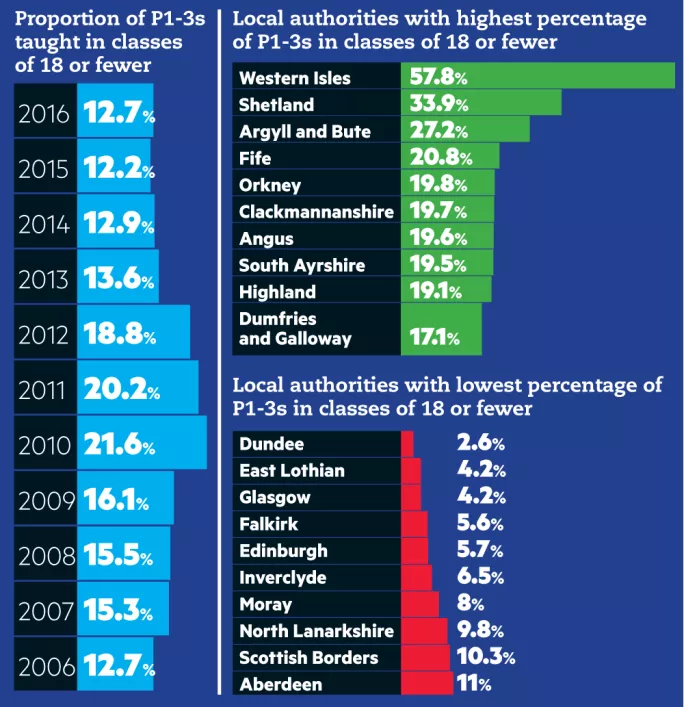Ten years on, SNP pledge to cut class sizes fails

The government has made zero progress in almost a decade on its one-time flagship education policy to reduce class sizes, figures reveal - and parents say the youngest pupils are actually now worse off.
New figures show that only 12.7 per cent of P1-3s are being taught in classes of 18 or fewer - exactly the same level recorded shortly before the SNP took power in 2007.
The party was elected after it emphasised its ambition to get P1-3 classes at or below that level, a move based on research that showed smaller classes had the biggest impact in the early years of formal education. But after initial progress - 21.6 per cent of P1-3s were in classes of 18 or fewer in 2010 - the trend has gone into reverse, despite a slight upturn this year. Meanwhile, the government has gradually diluted its commitment to smaller classes.
In practice, only 21,906 of P1-3s are in classes of 18 or fewer, down from 34,351 in 2010. Figures vary markedly across Scotland: in the Western Isles, 57.8 per cent are in classes at or below the 18-pupil threshold, compared with 2.6 per cent in Dundee (see data, below).

Policy shift towards councils
The quiet shelving of the class-size plan preceded the government pushing forward with its more recent policy to make councils maintain teacher numbers. Those that did not were punished last year with the withdrawal millions of pounds in funding.
Overall teacher numbers rose slightly this year, although the number in the secondary sector is down. The pupil-teacher ratio stayed at 13.7:1 for the third consecutive year.
Eileen Prior, executive director of the Scottish Parent Teacher Council, said that although the proportion was the same as in 2006, the experience of P1-3s would not be the same now, with a reduction in non-teaching staff meaning that pupils had less support in 2016. She was also wary of an “emotional” attachment to the idea of smaller classes, as research was inconclusive about their effect - especially if sizes were only being reduced slightly.
Greg Dempster, general secretary of primary school leaders’ body AHDS, said that reducing class sizes to a level at which teachers could make significant changes to their practice would require a “very, very expensive intervention”.
“I don’t know what the maths are, but you would need a lot more teachers,” he added.
He said the P1-3s policy probably suffered from a “heavy dose of pragmatism” after the global financial crash of 2008 hit education budgets. It had been a mistake to put “too much emphasis” on “one big policy idea”, rather than a mix of strategies, he added.
‘Address staff shortages first’
Now, Mr Dempster said, there was a need to plug existing staffing gaps in schools before thinking about class-size reductions. Although last week’s figures showed a slight increase in primary teachers across Scotland (from 23,425 in 2015 to 23,920), that was offset by drastic shortages in support staff, with knock-on effects for teachers’ workload.
The EIS teaching union has long argued for smaller classes. General secretary Larry Flanagan said he was disappointed that average sizes had inched upwards across primary schools as a whole (from 22.5 in 2010 to 23.5 this year).
He said: “Evidence clearly indicates that smaller class sizes are better for pupils and can have a significant impact on attainment. The trend of rising class sizes is an issue that must be tackled through greater investment in a greater number of qualified teachers.”
A Scottish government spokesman said that due to “constrained financial resources”, ministers had prioritised maintaining teacher numbers over class-size pledges.
‘Evidence clearly indicates that smaller class sizes are better for pupils’
He said: “We have committed a £88 million package of funding for Scotland’s local authorities to maintain pupil teacher ratios at 2015 levels in 2016-17 and secure places for all probationers who want them. The investment in teacher numbers will allow local authorities to take flexible decisions about how best to meet the needs of their schools and prevent further increases in class sizes.”
Education secretary John Swinney hailed the stable class sizes as “good news, particularly when you consider the teacher recruitment challenges being faced in some areas”.
The SNP’s 2007 manifesto stated: “We will reduce class sizes in P1-3 to 18 pupils or less (sic) to give children more time with their teacher at this vital stage of development.” The 2011 manifesto said smaller classes were “worth working for”. It made no mention of an 18-pupil target, but it did flag up imminent legislation to cap P1 classes at 25 pupils.
This year’s manifesto made no mention of class sizes, although last week’s school-statistics document described P1-3 classes of 18 or fewer as an “aspiration”.
@Henry_Hepburn
You need a Tes subscription to read this article
Subscribe now to read this article and get other subscriber-only content:
- Unlimited access to all Tes magazine content
- Exclusive subscriber-only stories
- Award-winning email newsletters
Already a subscriber? Log in
You need a subscription to read this article
Subscribe now to read this article and get other subscriber-only content, including:
- Unlimited access to all Tes magazine content
- Exclusive subscriber-only stories
- Award-winning email newsletters